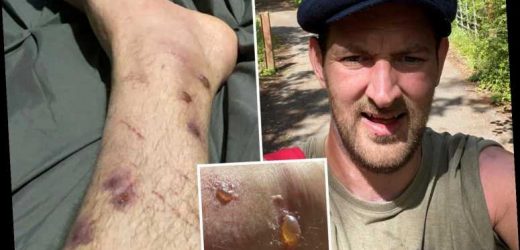A DAD was left "unable to walk" after brushing against a Giant Hogweed plant which left him with horrific third-degree burns.
Paul McGeachin, 40, suffered painful pus-filled blisters all over his legs after coming into contact with what is known as Britain's most dangerous plant.
The chef was rushed to hospital after the pain became so severe he could no longer stand up.
He was forced to take time off work and may even be scarred for life.
Paul had been out walking in Pollock, Glasgow, when he encountered the toxic plant.
He told the Daily Record: "It’s really dodgy. I was out and about going magnet fishing and was wearing three-quarter-length trousers.
"I didn’t know anything about it. I was none the wiser until the next day when I first felt irritation on my skin.
"At first I thought I could just use a dock leaf but it got worse."
The pain became so intense Paul was rushed to A&E where he was given a course of antibiotics and told to stay off his feet.
Doctors also warned him his blisters could take months to heal and may even scar him for life.
The dad could also suffer lifelong sunlight sensitivity – as is common when people come into contact with Giant Hogweed.
Paul said: "I have to just take it easy. I'm a chef so would normally be on my feet all day which I can't do.
"I'm just hoping it eases sooner rather than later."
GIANT HOGWEED – ‘MOST DANGEROUS PLANT’
What is giant hogweed?
It is an infamously dangerous plant which is common near rivers and streams.
What does it look like?
The plant can tower up to 25ft tall, with long green stems with purple blotches and huge branches of small white flowers and green leaves.
What can it do to you?
It causes a red rash, often followed by severe blistering within 24 hours. The resulting burns can last for several months and can leave skin sensitive to sunlight for years.
What can help?
The NHS advises covering the affected area and washing it with soap and water. If you begin to feel unwell after contact with giant hogweed, speak to your doctor and stay out of direct sunlight.
How to get rid of giant hogweed
The RHS advises wearing gloves, covering arms and legs, and wearing a face mask. Also immediately wash any skin that comes into contact with the plant and be wary of contaminated clothing and tools.
Paul, a keen magnet-fisher who regularly takes his daughter on country walks, has issued a warning to other families of the dangers of Giant Hogweed.
He said: "My daughter Jessica is three and is always picking up flowers.
"Giant Hogweed looks like wild garlic but with a much bigger flower. I just thank god she didn't see it."
Giant Hogweed – Heracleum mantegazzianum – has been dubbed "Britain's most dangerous plant" as it causes severe burns or even blindness.
The plant’s sap contains chemicals which react with light while in contact with the skin.
'BRITAIN'S MOST DANGEROUS PLANT'
Blisters usually form within 48 hours and in severe cases it can cause permanent scarring and even loss of sight.
Plants can tower up to 25ft tall, with long green stems with purple blotches, huge branches of small white flowers, and green leaves.
In the UK it is especially common to find it alongside rivers, which can transport the plant’s seeds.
Mike Duddy, of the Mersey Rivers Trust, previously branded Giant Hogweed "Britain's most dangerous plant".
The Royal Horticultural Society (RHS) describes the plant as a "serious risk to people who are unaware of its potential harm".
Last year mum Claire Hardwick warned about the dangers of Giant Hogweed after her three-month-old baby was hospitalised with raw burns and blisters.
And previously gardener Oliver Fenton was nearly blinded and left with horrific burns to his face when toxic sap from the plant squirted on him.
Source: Read Full Article






